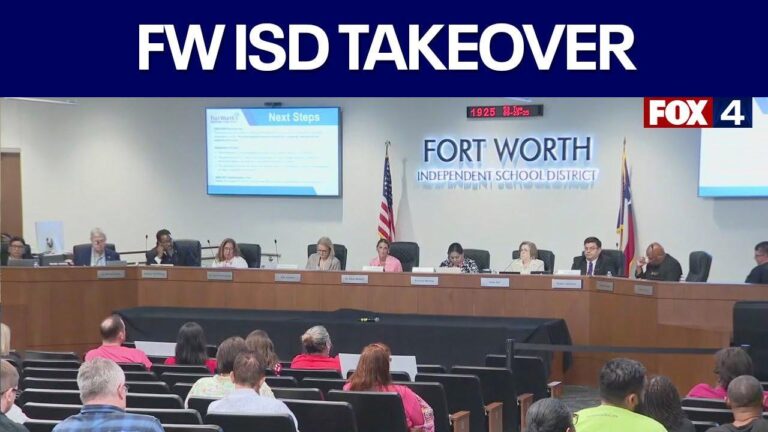Insights from HoustonŌĆÖs State Takeover: What Fort WorthŌĆÖs School District Can Expect
Understanding the Implications of a State Takeover for Fort Worth Schools
As Fort Worth braces for the possibility of its school district being placed under state control, families and local residents are understandably concerned about the future of their childrenŌĆÖs education. Examining Houston Independent School DistrictŌĆÖs (HISD) recent experience with state intervention provides valuable perspective on what such a transition might entail. HISDŌĆÖs takeover was prompted by ongoing academic underperformance and financial instability, leading to the appointment of state officials tasked with overhauling governance and instituting comprehensive reforms. These efforts focused on revamping curricula and reallocating resources, eliciting a mix of optimism and apprehension within the community.
Essential lessons from HoustonŌĆÖs takeover include:
- Enhanced state governance: Authority shifts from local boards to state-appointed leaders who implement turnaround plans.
- Emphasis on measurable outcomes: Policies become heavily influenced by standardized testing and accountability benchmarks.
- Community involvement hurdles: Initial reduction in local input often leads to feelings of disenfranchisement, though new engagement platforms gradually emerge.
- Financial restructuring: Stricter budget controls aim to eliminate deficits and prioritize funding toward critical educational needs.
| Area | HoustonŌĆÖs Experience | Expected Effects in Fort Worth |
|---|---|---|
| Governance | State-appointed leadership board | Likely similar external oversight |
| Academic Priorities | Focus on improving standardized test scores | Potential increased reliance on metrics |
| Community Influence | Local control diminished initially | Concerns about reduced stakeholder voice |
| Budget Management | Deficit elimination and tighter controls | More rigorous financial monitoring anticipated |
Major Obstacles Encountered During HoustonŌĆÖs State Oversight
HoustonŌĆÖs state intervention highlighted the multifaceted challenges of managing a large urban school district under external control. One of the foremost difficulties was restoring trust among parents, educators, and staff, who had become skeptical after years of governance issues. Communication gaps and lack of transparency hindered efforts to foster meaningful community participation. Financially, the district faced the daunting task of addressing inherited budget shortfalls while striving to maintain classroom funding.
Operational instability also plagued HISD, with frequent leadership changes disrupting policy continuity and strategic planning. Additional challenges included:
- High staff turnover: Frequent departures undermined instructional consistency and administrative stability.
- Persistent achievement disparities: Significant gaps in student performance required targeted interventions despite limited resources.
- Facility deterioration: Aging school buildings demanded urgent repairs even as funds were diverted to immediate reforms.
| Challenge | Effect | Response |
|---|---|---|
| Community Distrust | Low engagement from stakeholders | Implemented transparency initiatives |
| Financial Deficits | Resource allocation difficulties | Comprehensive budget restructuring |
| Leadership Turnover | Inconsistent policy direction | State-appointed board oversight |
Effective Approaches That Drove Progress in Houston Schools
HoustonŌĆÖs district recovery was propelled by deliberate strategies emphasizing accountability and community collaboration. A critical step involved revamping leadership by bringing in seasoned administrators who linked performance evaluations directly to student achievement. The district also prioritized professional development, equipping educators with training in data-informed instruction and culturally responsive pedagogy, which helped narrow achievement gaps and enhance teaching quality.
Engaging families and local organizations was another cornerstone of HISDŌĆÖs turnaround. Initiatives to boost parental involvement and establish student support networks outside the classroom were introduced. Transparency was reinforced through regular public reports and community meetings, fostering trust and shared responsibility. Key strategies included:
| Strategy | Outcome |
|---|---|
| Leadership Restructuring | Heightened accountability |
| Teacher Development Programs | Enhanced instructional effectiveness |
| Community Partnership Initiatives | Increased parental engagement |
| Data-Driven Instructional Decisions | Targeted student support |
Actionable Recommendations for Fort Worth Inspired by HoustonŌĆÖs Journey
Based on HoustonŌĆÖs experience, Fort WorthŌĆÖs education leaders should emphasize open, transparent communication with families and community members to quickly rebuild confidence. HoustonŌĆÖs takeover underscored the value of regular public forums and multilingual outreach to ensure inclusivity. Establishing clear feedback mechanisms can alleviate concerns about administrative changes and encourage cooperative problem-solving.
Proven strategies from Houston that Fort Worth could adapt include:
- Forming oversight committees with parent representation
- Implementing targeted academic support in struggling schools
- Developing early warning systems to identify students needing assistance
- Partnering with local nonprofits to provide wraparound services
| Houston Approach | Fort Worth Adaptation |
|---|---|
| Monthly stakeholder town halls | Bi-weekly virtual Q&A sessions |
| Dedicated academic diagnosticians | Expanded teacher training on data utilization |
| Collaborations with health agencies | Partnerships with local social service providers |
| Bilingual communication campaigns | Multi-language digital resources and support |
Final Thoughts
As Fort Worth navigates the complexities of a potential state takeover, the lessons gleaned from HoustonŌĆÖs experience offer a valuable framework filled with both obstacles and opportunities. Although the transition may require difficult adjustments, the ultimate goal remains steadfast: enhancing educational outcomes for every student. It is crucial for parents, educators, and community members to remain actively involved and well-informed throughout this process to ensure that the districtŌĆÖs transformation truly benefits Fort WorthŌĆÖs youth.




